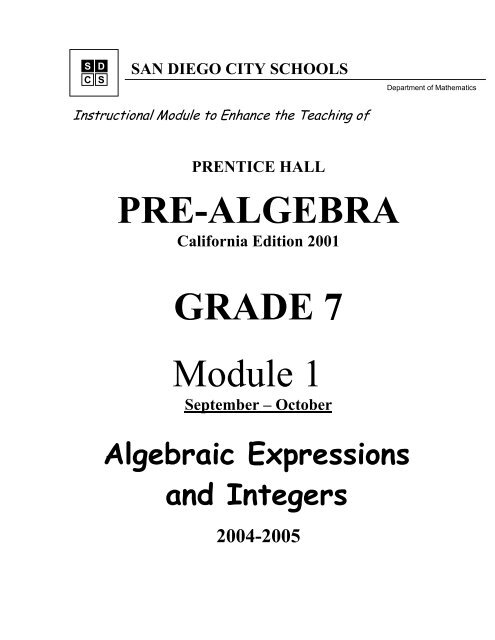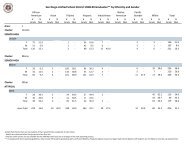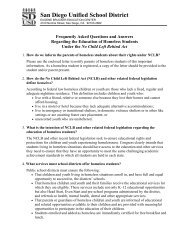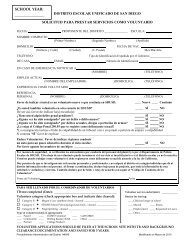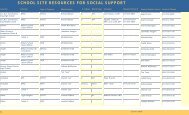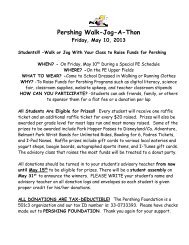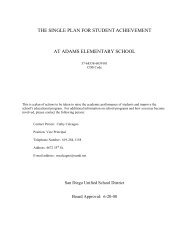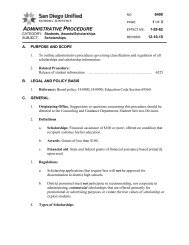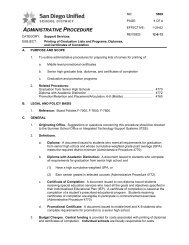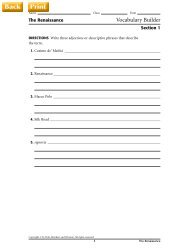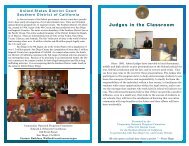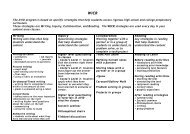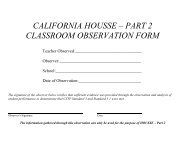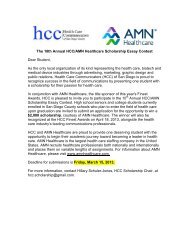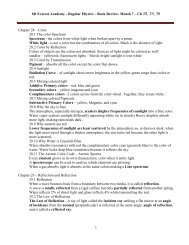PRE-ALGEBRA GRADE 7 Module 1 - San Diego City Schools
PRE-ALGEBRA GRADE 7 Module 1 - San Diego City Schools
PRE-ALGEBRA GRADE 7 Module 1 - San Diego City Schools
You also want an ePaper? Increase the reach of your titles
YUMPU automatically turns print PDFs into web optimized ePapers that Google loves.
S D<br />
C S<br />
SAN DIEGO CITY SCHOOLS<br />
Department of Mathematics<br />
Instructional <strong>Module</strong> to Enhance the Teaching of<br />
<strong>PRE</strong>NTICE HALL<br />
<strong>PRE</strong>-<strong>ALGEBRA</strong><br />
California Edition 2001<br />
<strong>GRADE</strong> 7<br />
<strong>Module</strong> 1<br />
September – October<br />
Algebraic Expressions<br />
and Integers<br />
2004-2005
MODULE 2: <strong>ALGEBRA</strong>IC EX<strong>PRE</strong>SSIONS and<br />
INTEGERS (Chapter 1)<br />
TRADITIONAL/YEAR ROUND CALENDAR ’04-05<br />
Day 1:<br />
September<br />
Chapter 1-3:<br />
Evaluate variable<br />
expressions and<br />
solve word<br />
problems<br />
Day 2:<br />
Chapter 1-4:<br />
Represent, graph,<br />
and order<br />
integers; to find<br />
opposites and the<br />
absolute value<br />
Day 3:<br />
Chapter 1-5:<br />
Addition of<br />
integers<br />
Day 4:<br />
Chapter 1-6:<br />
Subtraction of<br />
integers<br />
Day 5:<br />
OCTOBER<br />
Chapter 1-6:<br />
Subtraction of<br />
integers<br />
Day 6:<br />
Day 7:<br />
Day 8:<br />
Day 9:<br />
Day 10:<br />
Chapter 1-7:<br />
Use inductive<br />
reasoning to make<br />
predictions &<br />
formulate<br />
conjectures about<br />
patterns<br />
Chapter 1-9:<br />
Multiplication of<br />
integers<br />
Chapter 1-9:<br />
Division of<br />
integers<br />
Chapter 1-10:<br />
Graph in the<br />
coordinate plane<br />
Chapter 1-8:<br />
Solve problems by<br />
looking for a<br />
pattern<br />
Day 11:<br />
Day 12:<br />
Assessment:<br />
Chapter 1<br />
Assessment:<br />
Alternative<br />
Assessment, Chap.<br />
1 Support File, p36<br />
FLEX<br />
October
KEY MATHEMATICAL CONCEPTS <strong>GRADE</strong> SEVEN<br />
“BIG IDEAS”:<br />
By the end of grade seven, students will:<br />
• Know the properties of, and compute with, rational numbers by manipulating<br />
numbers and equations. Know and use different representations of<br />
fractional numbers (fractions, decimals, and percents) and are proficient at<br />
changing from one to another. Understand and use factoring of numerators<br />
and denominators and properties of exponents.<br />
Note: Negative fractions are formally introduced and studied for the first<br />
time.<br />
• Increase their facility with ratio and proportion, compute percents of increase<br />
and decrease, and compute simple and compound interest.<br />
• Graph linear functions and understand the idea of slope and its relation to ratio.<br />
Solve simple linear equations and inequalities over the rational numbers.<br />
• Know the Pythagorean theorem and solve problems in which they compute the<br />
length of an unknown side.<br />
Note: The Pythagorean theorem is probably the first true theorem that the<br />
students will have seen.<br />
• Know how to compute the surface area and volume of basic three-dimensional<br />
objects and understand how area and volume change with a change in scale.<br />
• Make conversions between different units of measurement. Know and use<br />
various forms of displays for data sets.<br />
(Notes from Mathematics Framework for California Public <strong>Schools</strong>, Grade Seven, p149-152.)<br />
Key Mathematical Concepts Addressed in Chapter 1 –<br />
Algebraic Expressions and Integers<br />
• AF 1.1, 1.2, 1.4 Use variables to write expressions and order of<br />
operations to evaluate algebraic expressions.<br />
• *NS 2.5 Interpret absolute value of a number using a number line.<br />
• *NS 1.2, AF 1.3 Add and subtract integers. (Introduce<br />
multiplying/dividing integers.)<br />
• AF 1.5 Represent quantitative relationships graphically (coordinate<br />
plane).<br />
• MR 1.1, 1.2, 2.4 Make and test conjectures using inductive reasoning.
DRAFT COPY - <strong>PRE</strong>NTICE HALL – <strong>GRADE</strong> 7 <strong>PRE</strong><strong>ALGEBRA</strong> - DRAFT COPY<br />
MODULE 1: Algebraic Expressions and Integers<br />
DAY 1: LESSON 1-3, pp 13 - 16<br />
LESSON FOCUS:<br />
Evaluate variable expressions and solve word problems by evaluating expressions.<br />
CA STANDARD: AF 1.2<br />
Purpose of Lesson:<br />
Warm-up/ Routine(s):<br />
LAUNCH:<br />
EXPLORE:<br />
Materials: Overhead of<br />
chart, p. 15, Calories<br />
Per Hour . . .<br />
Practice:<br />
SUMMARIZE:<br />
Homework:<br />
Closure:<br />
At the end of the lesson students will be able to substitute a value for a<br />
variable and evaluate a variable expression to solve a real world problem.<br />
Write on board: Writing Variable Expressions<br />
1) Nine more than a number y<br />
2) 4 less than a number n<br />
3) A number z times 3<br />
4) A number a divided by 12<br />
5) 6 times the quantity 4 plus a number c<br />
Students translate the word phrases into variable expressions.<br />
TE p13 Connecting to Students’ Lives: (Babysitting - pay per hour, i.e. $2/h where h<br />
is the number of hours worked)<br />
Have students suggest some examples & compute what the sitter would make.<br />
On board or on an overhead, make chart, p15, Calories Per Hour Used by a 100-lb<br />
Walker. Do a & b together as a class.<br />
Have partners write their own story statements & find out how many calories would<br />
be used for a participant in a walking marathon from Pt. Loma to Qualcomm<br />
Stadium. At some time during the race, walkers use each of the four types of<br />
walking on the chart. The average walker takes about 10 hours, some finished in less<br />
than that time and others take a great deal longer. Give your walker a name & write<br />
about his/her progress in the race.<br />
Share at tables & if time with class. Teacher moves from group to group, helping<br />
students clarify which values are variables/which coefficients.<br />
In small groups: Textbook p16; #36 (Carnival)<br />
Textbook p15 # 1-10 Check Understanding<br />
In sharing, look for partner stories that correctly use hours as variable & number<br />
of calories as coefficient with a clear explanation about “why” this is done & “what”<br />
it tells us about the runner.<br />
Time to reflect back on the purpose of the lesson, and help students make<br />
meaningful connections.<br />
Textbook: p16 #35. Statistics *(Babies born)<br />
Textbook p16; Mixed Review #38-44<br />
*Extension: Approximate number of babies born in a week? A month?
DRAFT COPY - <strong>PRE</strong>NTICE HALL – <strong>GRADE</strong> 7 <strong>PRE</strong><strong>ALGEBRA</strong> - DRAFT COPY<br />
MODULE 1: Algebraic Expressions and Integers<br />
DAY 2: LESSON 1-4, pp 17 - 21<br />
LESSON FOCUS:<br />
To represent integers on a number line and order integers. To find the<br />
opposites and absolute values<br />
CA STANDARD:<br />
NS 2.5 (Key Standard)<br />
MR 2.5<br />
Purpose of Lesson:<br />
At the end of the lesson, students will be able to represent on a number<br />
line & order integers and find opposites & absolute values.<br />
Warm-up/<br />
Routine(s):<br />
Materials: Post-its with<br />
integers on them<br />
Mental Math: Draw a long number line –10 to 10 on board. Pass out post-its<br />
to 4-5 students with integers on them. (Direct them to place the number<br />
appropriately along the number line.)<br />
Small groups discuss placement – share out as class describing the number<br />
in reference to how far it is from 0 (Reference: p18, Example 2).<br />
LAUNCH:<br />
Vocabulary: Opposites,<br />
absolute value<br />
EXPLORE:<br />
Materials: Use tape to<br />
mark off a long number<br />
line on classroom floor<br />
Introduction to opposites & absolute value:<br />
Ask students: “What is the same about 3 and –3?”<br />
Develop Understanding:<br />
Pass out large cards with integers on them to 4-5 students. As each<br />
student takes his/her place along the number line, ask for a volunteer to<br />
stand at the integer’s opposite. Students describe their position along the<br />
number line in reference to the distance that they are from zero.<br />
Direct Teaching: (Ref: p18, Part 2).<br />
-That distance is called absolute value and it is written this way 3 .<br />
Put on board: 2 -8 -10 10 -5 1 -6 –4 4<br />
Students write absolute value for each/volunteers write on board to check.<br />
Practice: Textbook p19; Check Understanding, #1-10<br />
SUMMARIZE:<br />
Closure:<br />
What do you know about the distance from zero of an integer and its<br />
opposite? How is that related to absolute value? How far is zero from zero<br />
on the number line? What would the absolute value of zero be?” EXPLAIN<br />
your thinking.<br />
Time to reflect back on the purpose of the lesson, and help students make<br />
meaningful connections.<br />
Homework: Textbook: p21, Mixed Review, #63-68<br />
Extension: p21, Critical Thinking, #62
DRAFT COPY - <strong>PRE</strong>NTICE HALL – <strong>GRADE</strong> 7 <strong>PRE</strong><strong>ALGEBRA</strong> - DRAFT COPY<br />
MODULE 1: Algebraic Expressions and Integers<br />
DAY 3: LESSON 1-5, pp 23 -28<br />
LESSON FOCUS:<br />
CA STANDARD:<br />
Purpose of Lesson:<br />
Warm-up/<br />
Routine(s):<br />
LAUNCH:<br />
EXPLORE:<br />
Materials: Two color<br />
counters or color tiles<br />
Vocabulary: Zero pair<br />
Practice:<br />
SUMMARIZE:<br />
Homework:<br />
Closure:<br />
To use models, number lines and rules to add integers<br />
NS 1.2 (Key Standard)<br />
AF 1.3 (Key Standard)<br />
At the end of the lesson, students will be able to solve integer problems<br />
using addition.<br />
Number Sense: Order of Operations (Review)<br />
Simplify the following expressions:<br />
4 + 15 3 10 – 1 7 3 5 – 8 4 + 6 2[ (13 – 4) 3]<br />
TE p23, Connecting to Students’ Lives<br />
Ask students to think of a number; add five; subtract 3; subtract five; add<br />
three. What is the result? Why? (Inverse of a number: “doing and<br />
undoing”) You may want to do a couple of these until students fully grasp<br />
the concept.<br />
INTRODUCE CONCEPT: See below for “Human Number Line” model<br />
Teacher reviews p22, EX 1 and 2, highlighting “zero pair” model.<br />
Use 2-color chips; +/ - tiles; etc. Ask students to complete p22, 1-16, using<br />
their models.<br />
Textbook p26; 1-12 Check Understanding OR<br />
Reteaching Worksheet TE p28<br />
“Why can you add or remove any number of the zero pairs?”<br />
“What is a simple rule for addition of integers?”<br />
Time to reflect back on the purpose of the lesson, and help students make<br />
meaningful connections.<br />
Textbook p27; #51 and 68; and if appropriate<br />
Practice or Reteach Worksheet, p 28<br />
HUMAN MODEL ON A NUMBER LINE: Create a large number line (masking tape works well) on<br />
the floor or wall where students can see. Mark: –10; -5; 0; 5; 10 with tape hash marks. Model by<br />
always starting at zero and always facing forward (toward the positive). A positive number means<br />
to step that many steps toward the positive and a negative number means to step that many paces<br />
backward toward the negative. (Note: DO NOT TURN AROUND – walk backward!)<br />
Example: 3 + 4 = 7 Start at 0; walk 3 steps forward to 3; walk 4 steps forward to 7.<br />
Example: -3 + (-2) = -5 Start at 0; walk backward 3 steps to –3; walk 2 steps backward to –5.<br />
Example: 3 + (-2) = 1 Start at 0; walk 3 steps forward to 3; walk 2 steps backward to 1.<br />
Example: 3 + (-5) = -2 Start at 0; walk 3 steps forward to 3; walk 5 steps backward to -2.
DRAFT COPY - <strong>PRE</strong>NTICE HALL – <strong>GRADE</strong> 7 <strong>PRE</strong><strong>ALGEBRA</strong> - DRAFT COPY<br />
MODULE 1: Algebraic Expressions and Integers<br />
DAY 4: LESSON 1-6, pp 29 - 34<br />
LESSON FOCUS:<br />
CA STANDARD:<br />
Use models, number lines and rules to subtract integers<br />
NS 1.2 (Key Standard)<br />
Purpose of Lesson:<br />
Warm-up/<br />
Routine(s):<br />
At the end of the lesson, students will be able to solve integer problems<br />
using subtraction.<br />
Number Sense: Order of Operations (Review)<br />
12 – 8 2 4( 4 ) – 2 21 7 + 14 [2 + (6 8)] -1<br />
LAUNCH:<br />
TE p29 Connecting to Students’ Lives (Skateboard)<br />
TE p29, #1-3 Try This (center of page): Using models, have students<br />
subtract.<br />
How can you subtract: 4 – 8 = Using a Model? (2-color chips; +/ - tiles;<br />
etc)<br />
Ask students to circle the terms that are separated by an addition or<br />
subtraction (operation) sign; and add as many “zero pairs” as needed.<br />
EXPLORE: See below for “Human Number Line” model<br />
Practice:<br />
Ask students to complete Textbook p31, #14-19 using their model(s).<br />
Use models to solve: Textbook p31; 1-10; Check Understanding<br />
SUMMARIZE:<br />
Homework:<br />
Closure:<br />
“What is a simple rule for subtraction of integers?”<br />
“Why can you add or remove any number of the zero pairs?”<br />
Time to reflect back on the purpose of the lesson, and help students make<br />
meaningful connections.<br />
Text p33 Error Analysis<br />
Reteaching Worksheet TE p33 using models.<br />
Draw the models to show solution.<br />
HUMAN MODEL ON A NUMBER LINE: Create a large number line (masking tape works well) on the floor or<br />
wall where students can see. Mark: –10; -5; 0; 5; 10 with tape hash marks. Model by always starting at zero<br />
and facing forward (toward the positive). A positive number means to step that many steps toward the<br />
positive and a negative number means to step that many paces backward toward the negative. NOTE: DO<br />
NOT TURN AROUND for addition. TURN AROUND for subtraction, as it is the opposite of addition, and<br />
follow addition “rules”.<br />
Example: 3 - 4 = -1 Start at 0; walk 3 steps forward to 3; TURN AROUND for subtraction,<br />
which is opposite of addition; now walk 4 steps forward to -1.<br />
Example: -3 - (-2) = -1 Start at 0; walk backward 3 steps to –3; TURN AROUND for<br />
subtraction, which is opposite of addition; walk 2 steps backward to –1.<br />
Example: 3 - (-2) = 5 Start at 0; walk 3 steps forward to 3; TURN AROUND for subtraction,<br />
which is opposite of addition; walk 2 steps backward to 5.<br />
Example: 3 - (-5) = 8 Start at 0; walk 3 steps forward to 3; TURN AROUND for subtraction,<br />
which is opposite of addition; walk 5 steps backward to 8.
DRAFT COPY - <strong>PRE</strong>NTICE HALL – <strong>GRADE</strong> 7 <strong>PRE</strong><strong>ALGEBRA</strong> - DRAFT COPY<br />
MODULE 1: Algebraic Expressions and Integers<br />
DAY 5: LESSON 1-6, pp 29 - 34<br />
LESSON FOCUS:<br />
CA STANDARD:<br />
To use models, number lines and rules to subtract integers<br />
NS 1.2 (Key Standard)<br />
Purpose of Lesson:<br />
Warm-up/<br />
Routine(s):<br />
At the end of the lesson, students will be able to solve integer problems<br />
using subtraction.<br />
Number Sense: Order of Operations (Review)<br />
Compare. Use or or = to complete each statement.<br />
15 3 – 2 ___ 15 (3 – 2) 8 + 12 4 ___ (8 + 12) 4<br />
12 3 + 9 4 ___ 12 (3 + 9) 4<br />
LAUNCH:<br />
Materials: Overhead of<br />
game board,<br />
transparent chips or<br />
markers<br />
Integer Four–in-a-Row: See following page(s) of <strong>Module</strong>. On transparency,<br />
begin by playing with the whole class.<br />
EXPLORE:<br />
Materials: Copy of<br />
game board for each<br />
pair of students,<br />
different kind of<br />
markers for each player<br />
Duplicate and distribute Integer Four–in-a-Row: See following page(s) of<br />
<strong>Module</strong> 2 for partner play. Use the 2-color counters as markers.<br />
Practice:<br />
Integer Choices: See following page(s) of the <strong>Module</strong>.<br />
SUMMARIZE:<br />
What strategies helped you line up your markers in a row?<br />
Why did it work? What did it help you know as you played the game?<br />
What do you know about subtracting a negative number from a positive<br />
number? A negative number subtracted from a negative number?<br />
Closure:<br />
Time to reflect back on the purpose of the lesson, and help students make<br />
meaningful connections.<br />
Homework: p. 28, # 69-72<br />
p. 28, Mixed Review, # 74 - 81
DRAFT COPY - <strong>PRE</strong>NTICE HALL – <strong>GRADE</strong> 7 <strong>PRE</strong><strong>ALGEBRA</strong> - DRAFT COPY<br />
MODULE 1: Algebraic Expressions and Integers<br />
DAY 6: LESSON 1-7, pp 35-39<br />
LESSON FOCUS: Use inductive reasoning to make predictions & formulate conjectures about<br />
patterns.<br />
CA STANDARD: MR 1.1; MR 1.2; MR 2.4<br />
Purpose of Lesson:<br />
At the end of the lesson, students will be able to write rules for<br />
patterns & make predictions and test conjectures.<br />
Warm-up/<br />
Routine(s):<br />
LAUNCH:<br />
Vocabulary: Inductive<br />
reasoning, Conjecture<br />
Materials: Make a<br />
square card similar to<br />
the diagram in Example<br />
1, p35<br />
Number Sense: Daily Skills Warm Up, Lesson 1-6, TE p 29 - Overhead (OH)<br />
Introduce vocabulary: Inductive reasoning is making conclusions based on<br />
patterns you observe. A conclusion by inductive reasoning is a conjecture.<br />
Turn the card clockwise and ask students for their “observation” about<br />
what’s happening & their “prediction” of what the card will look like next.<br />
Help students differentiate between observation & conjecture &<br />
understand that they are using inductive reasoning to come to a conclusion.<br />
Do on board with students: Patterns, EXAMPLE 2, p35 & EX. 3, p36, a, b, c<br />
***HELP STUDENTS WRITE A RULE FOR EACH PATTERN!<br />
EXPLORE:<br />
Turn to p39 and begin the pattern seen in #23. Go slowly row by row so<br />
students have an opportunity to start seeing what is happening. Have them<br />
copy the pattern.<br />
Student partners add three more rows, then find the sum of each row and<br />
predict the sum of the numbers of the ninth row, 12 th row, 20 th row . . .<br />
Ask students to work together at their tables to find as many patterns as<br />
they can. Challenge them to write a rule for what is happening as the<br />
pattern continues to grow.<br />
Practice: Check Understanding, p38, 1 - 8<br />
SUMMARIZE:<br />
QUICK WRITE:<br />
When does a conclusion become a conjecture? Give an example.<br />
Closure:<br />
Time to reflect back on the purpose of the lesson, and help students make<br />
meaningful connections.<br />
Homework:<br />
Success Building & Problem Masters booklet, p102, Finding Patterns
DRAFT COPY - <strong>PRE</strong>NTICE HALL – <strong>GRADE</strong> 7 <strong>PRE</strong><strong>ALGEBRA</strong> - DRAFT COPY<br />
MODULE 1: Algebraic Expressions and Integers<br />
DAY 7: LESSON 1-9, pp 44-49<br />
LESSON FOCUS:<br />
CA STANDARD:<br />
To multiply integers using repeated addition, models, patterns and rules<br />
NS 1.2 (Key Standard)<br />
Purpose of Lesson:<br />
By the end of the lesson, students will be able to solve integer problems<br />
using multiplication.<br />
Warm-up/<br />
Routine(s):<br />
LAUNCH:<br />
Mental Math: TE p49 in lower margin Checkpoint/ Mini-Assessment (on<br />
overhead)<br />
TE p44 Connecting to Students’ Lives (Video games)<br />
(500 cents + -25 + -25 + -25 . . .)<br />
TE p44 Introduce the Concept: Teacher copies the table and together with<br />
students completes the operations discovering & discussing the patterns<br />
that occur.<br />
TE p45 Example #2: Teacher copies and together with students completes<br />
expanding the pattern from positive to negative multiplier. Students<br />
discover/ discuss the patterns that occur.<br />
Note: Refer to “opposite of” when referencing –1(5) = -5; 1(5) = 5;<br />
- means “the opposite of”, SO -1(5)= the opposite of 5 or –5.<br />
AND -2(-5) = 10; 2(-5) = -10; - means “the opposite of”, SO -2(-5) = the<br />
opposite of –10 or +10.<br />
EXPLORE:<br />
Reference: p 45<br />
Have student partners extend patterns in the same manner:<br />
-3 (4) -3 (-4) -2 (15) -2 (-15)<br />
Partners try to write generalized rules for multiplying integers:<br />
Product of 2 integers with same sign =<br />
Product of 2 integers with different sign =<br />
Product of zero =<br />
Practice: P 44, TRY THIS, #4, 5, 6<br />
SUMMARIZE:<br />
Share generalized rules – chart in student language with an example for<br />
each rule.<br />
What patterns do you notice? Do the rules “make sense”? …based on the<br />
patterns?<br />
Closure:<br />
Time to reflect back on the purpose of the lesson, and help students make<br />
meaningful connections.<br />
Homework: P 45, TRY THIS, #8, 9, 10<br />
Textbook p47; Check Understanding #1, 2, 3, 4, 6, 7, 9<br />
Optional: Poster Report
DRAFT COPY - <strong>PRE</strong>NTICE HALL – <strong>GRADE</strong> 7 <strong>PRE</strong><strong>ALGEBRA</strong> - DRAFT COPY<br />
MODULE 1: Algebraic Expressions and Integers<br />
DAY 8: LESSON 1-9, pp 44-49<br />
LESSON FOCUS:<br />
CA STANDARD:<br />
To divide integers using repeated addition, models, patterns and rules<br />
NS 1.2 (Key Standard)<br />
Purpose of Lesson:<br />
By the end of the lesson students will be able to solve integer problems<br />
using division.<br />
Warm-up/<br />
Routine(s):<br />
LAUNCH:<br />
Mental Math: Number Sense<br />
Daily Skills Warm Up Transparency, Lesson 1-9, TE p44<br />
Refer students back to their chart of multiplication of integers rules.<br />
Ask students to provide an additional example for each rule.<br />
EXPLORE:<br />
Put the following on board:<br />
12 3 = -12 (-3 ) = 12 (-3) = -12 3 =<br />
Reference: p 46<br />
Students work with a partner & use what they know about the rules for<br />
multiplication of integers to try to figure out what the results might be for<br />
each expression. Once they have solutions, they check with their table<br />
group and explain to one another why they think their solutions are<br />
correct. Explanations should be based upon “because I know _____ about<br />
multiplying integers then I think . . .”<br />
Teacher facilitates conversation. (Depending upon the results, you may have<br />
to step in with direct instruction. You can demonstrate that division is<br />
simply multiplication by the reciprocal so students SEE what is happening.<br />
Trying to do this on a number line or repeated subtraction really gets<br />
messy & confusing even for the best of us!)<br />
Chart rules for division of integers with an example for each.<br />
Practice: P 46, TRY THIS, #11, 12, 13<br />
SUMMARIZE:<br />
How are multiplication and division of integers similar?<br />
What patterns do you noticed?<br />
Do the rules “make sense”? …based on the patterns?<br />
Closure:<br />
Time to reflect back on the purpose of the lesson, and help students make<br />
meaningful connections.<br />
Homework: Textbook p47; Check Understanding #5, 8, 10, 11a,b,c & #25, 26, 31 - 34
DRAFT COPY - <strong>PRE</strong>NTICE HALL – <strong>GRADE</strong> 7 <strong>PRE</strong><strong>ALGEBRA</strong> - DRAFT COPY<br />
MODULE 1: Algebraic Expressions and Integers<br />
DAY 9: LESSON 1-10, pp 50 -54<br />
LESSON FOCUS:<br />
To name the four quadrants in the coordinate plane and to name and graph<br />
points in the coordinate plane<br />
CA STANDARD: AF 1.5<br />
Purpose of Lesson:<br />
Warm-up/<br />
Routine(s):<br />
At the end of the lesson, students will be able to name and graph points<br />
in the coordinate plane.<br />
Mini-Assessment:<br />
CHECKPOINT 2, p 49 (Selected problems: #1, 4, 7, 9, 10, 11)<br />
LAUNCH:<br />
Vocabulary: Coordinate<br />
plane, x-axis, y-axis,<br />
quadrant, origin, ordered<br />
pair, x-coordinate, y-<br />
coordinate<br />
EXPLORE:<br />
Materials: Graph paper,<br />
(rulers available)<br />
Ask students how many of them know how to play Battleship. Have someone<br />
briefly tell how it is played.<br />
Use Transparency 38, TE p3, as a visual for identifying x-axis and y-axis,<br />
quadrants, & origin. Use –3 and 4 as on ordered pair & demonstrate<br />
plotting the points. Make up a few more examples & plot.<br />
By small groups: Assign Textbook p54; #59 and #60 Part a – d;<br />
2 groups do #59 and #60a; 2 groups do #59 and #60b; and so on.<br />
Complete on graph paper and share transformations.<br />
Textbook p54; #58 Open-ended<br />
Practice:<br />
SUMMARIZE:<br />
Closure:<br />
Homework:<br />
Have students exchange coordinates and draw partner’s picture, following<br />
the ordered pairs.<br />
QUICK WRITE: In your own words, explain how to plot this ordered pair:<br />
(-5, 6).<br />
Time to reflect back on the purpose of the lesson, and help students make<br />
meaningful connections.<br />
p 54, MIXED REVIEW, #62 – 68, and p 54, JUSTIFY EACH STEP<br />
Additionally, if assigned: Continue to work on Poster Report.
DRAFT COPY - <strong>PRE</strong>NTICE HALL – <strong>GRADE</strong> 7 <strong>PRE</strong><strong>ALGEBRA</strong> - DRAFT COPY<br />
MODULE 1: Algebraic Expressions and Integers<br />
DAY 10: LESSON 1-8, pp 40-43<br />
LESSON FOCUS:<br />
To develop generalizations and solve a problem by looking for a pattern<br />
CA STANDARD: MR 3.3<br />
Purpose of Lesson:<br />
Warm-up/<br />
Routine(s):<br />
At the end of the lesson, students will be able to identify a pattern and<br />
solve problems using patterns. Students will begin to make generalizations.<br />
Number Sense: Pico, Ferme, Bagel – A Game of Logic (See Routines/ Warmup<br />
Bank for directions)<br />
LAUNCH:<br />
EXPLORE:<br />
Practice:<br />
Handshake Problem: TE p40 Additional Example to Check Understanding:<br />
Each student on a committee with five members shakes hands with every<br />
other member. How many handshakes will there be in all? (10)<br />
Model this exercise with the students.<br />
Students work together to answer the following:<br />
What if there were six members on the committee? Ten? Twenty?<br />
Explain in words what is happening to the pattern as the committee grows<br />
to more & more members.<br />
Allow time for them to them to investigate & organize in any manner they<br />
wish. Focus is not the organization – it’s the thinking & generalizing.<br />
Challenge students to verbally make a general statement about what is<br />
happening as the pattern grows. Move from group to group facilitating<br />
efforts.<br />
Textbook p42 #1; write a statement about how the pattern is growing.<br />
SUMMARIZE:<br />
Homework:<br />
Closure:<br />
Chart student statements & check with the pattern to see if each works.<br />
Try to make sure to ground each statement in the problem.<br />
Time to reflect back on the purpose of the lesson, and help students make<br />
meaningful connections.<br />
Solve each pattern problem and in words, explain how the pattern is<br />
growing.<br />
Textbook p43, #2, 4; MIXED REVIEW, 11 - 17<br />
Additionally if assigned: Continue work on Poster Report
DRAFT COPY - <strong>PRE</strong>NTICE HALL – <strong>GRADE</strong> 7 <strong>PRE</strong><strong>ALGEBRA</strong> - DRAFT COPY<br />
MODULE 1: Algebraic Expressions and Integers<br />
DAY 11: LESSON Assessment<br />
LESSON FOCUS:<br />
CA STANDARD:<br />
Chapter Assessment – Key Understandings: Use addition, subtraction,<br />
multiplication and division of integers accurately in problem solving and<br />
using a variable & writing a variable expression.<br />
Chapter 1 Standards<br />
Purpose of Lesson:<br />
Warm-up/<br />
Routine(s):<br />
LAUNCH:<br />
To assess student understanding(s) of using addition, subtraction,<br />
multiplication, & division of integers accurately in problem solving and using<br />
a variable & writing a variable expression<br />
If assigned: In small groups, share Poster Reports OR<br />
Overhead, AFTER THE LESSON, TE p18, Write an integer to represent<br />
each situation.<br />
Review test-taking skills<br />
EXPLORE: Chapter 1 Alternative Assessment (Duplicate Chapter 1 Support File p36)<br />
Practice:<br />
SUMMARIZE:<br />
Closure:<br />
Homework:<br />
TE p16 Enrichment Worksheet for “early finishers”<br />
Write a Chapter Reflection in Math Notebook.<br />
What did you already know how to do from this chapter?<br />
What new or additional information/vocabulary did you learn?<br />
How do you think you did on the final assessment?<br />
What do you wish had been asked on the assessment, that was not, to<br />
demonstrate your further understanding of the content of this chapter?<br />
If you had to tell another student what the most important mathematical<br />
learning or understanding was in this chapter, what would you say? Why?<br />
TE p16 Enrichment Worksheet


